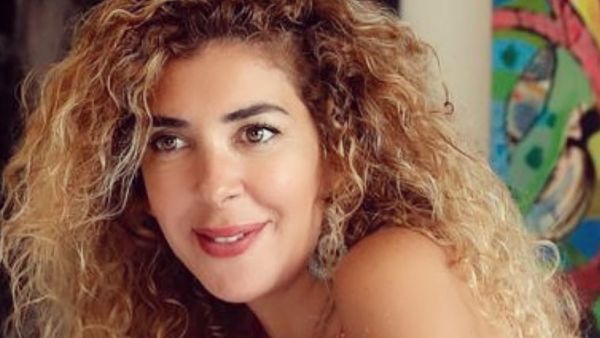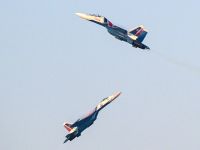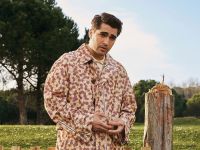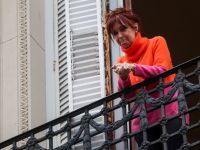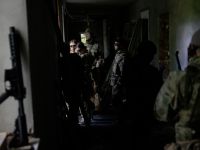“The colors in my paintings come from my childhood memories. My dad used to work in agriculture, so it was always about nature, flowers and trees,” Lebanese artist Louma Rabah tells Arab News. “My happiness is in nature — even a gloomy tree can make me happy.”
Rabah’s parents divorced when she was just 18 months old and she went to live with her father, her half-Austrian stepmother (“who I regard as my second mum”), and her siblings. They fled Lebanon in 1985 because of the civil war and went to live in Vienna, then Egypt, before returning to Lebanon in 1990.
#FlashbackFriday to #Beirut & the studio of Lebanese #artist, Louma Rabah - one of the most interesting painters I have ever had the pleasure of meeting. I visited her beautiful home in the suburb of #Ashrafieh & spoke about where she gets her inspiration from. #Flashback #film pic.twitter.com/sbWgl25hfI
— Daizy Gedeon (@DaizyGedeon) August 29, 2019
“I met up with my mother again in Italy when I was 15,” Rabah says. “She was living with her artist husband. She is also a painter, gifted at watercolors. Today she lives in Lebanon and we are close.”
Rabah’s parents divorced when she was just 18 months old and she went to live with her father, her half-Austrian stepmother (“who I regard as my second mum”), and her siblings. They fled Lebanon in 1985 because of the civil war and went to live in Vienna, then Egypt, before returning to Lebanon in 1990.
“I met up with my mother again in Italy when I was 15,” Rabah says. “She was living with her artist husband. She is also a painter, gifted at watercolors. Today she lives in Lebanon and we are close.”
‘Surviving the 4th of August’
This is the painting I was working on the morning of the port explosion. It was still wet when my home was damaged, and the shards of broken glass dried on the canvas. Volunteers came and tried to brush off the glass, leaving footprints. But the couple that bought it said they wanted it left as it was. So I left the glass embedded in it and we wrote on the back that it had survived the August 4 blast.
Another amazing one by same artist:
— Mosul Eye عين الموصل (@MosulEye) November 17, 2019
loumarabah pic.twitter.com/tVkwdYTtIS
‘Escape in Nature’
This depicts the nature in the mountains where my mother lives. She has a beautiful garden connected to the valley where you can walk into endless wild flowers. When I take a photo, people think I’ve edited it; the colors are so vibrant. I painted this after the blast. You can feel the strokes are strong. When I did it I was angry — but I put it into something I liked, so I calmed myself. When I’m feeling angry or negative, I don’t paint the negativity — I don’t like to put my sadness or dark periods on the canvas because I think if I have the chance to make something prettier or happier, why not? After I paint something positive, my mood changes. It’s like therapy. A lot of artists painted the destruction after the blast, but it wasn’t something I wanted to put on canvas or even to see ever again. It doesn’t help me in any way.
‘Blooming Cactus’
I painted this when I was still married. I wasn’t a painter then — I was just painting at home. But I enjoyed doing this. I like the cactus; it’s a very resilient plant, very strong. Whatever the conditions, it still grows. Visually it’s very nice too — they look like little sculptures. You can see that, over time, my art has changed. Some of my early work was very orderly and constrained, but my new paintings are more free and abstract.
‘Field of Wild Flowers’
When you start making abstract art, it means you’re becoming more confident. With time you can — like a good writer — say less and project more. You get to convey what you’re feeling without having to paint every detail. Sometimes, I still go into nature and paint what I’m seeing, but most of the time it’s a feeling I want to put on canvas. I don’t think before I paint. I know what colors I’m feeling and what mood I’m in, but the outcome is a total surprise. I like to be free to paint whatever I wish. An artist shouldn’t worry about what people will like or not. They should be honest. People who paint are very lucky because we are free. We are doing what makes us happy and relaxed.
‘Cedar Tree in Spring’
In Lebanon we have beautiful nature and trees. It’s what makes us special in the Arab world. During this interview, I’m speaking to you from Dubai. I came here to stay with my sister, whose boyfriend was killed in the port blast. After this tragedy she decided to move to the UAE, where she has friends. On my first day in Dubai, I opened the window and there were New Year fireworks and people were clapping and laughing on the seafront. It made me cry because of the contrast between what Lebanon is facing now. But I’m looking forward to going home. I miss everything — my neighbors, the street, my studio.
This article has been adapted from its original source.


